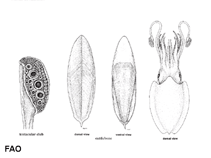Rhombosepion orbignyanum (Férussac, 1826)
Pink cuttlefish
Classification / Names Common names | Synonyms | CoL | ITIS | WoRMS
Cephalopoda | Sepiida | Sepiidae
Environment: milieu / climate zone / depth range / distribution range Ecology
Demersal; brackish; depth range 15 - 570 m (Ref. 1695), usually 50 - 250 m (Ref. 1695). Subtropical; 55°N - 17°S, 22°W - 36°E (Ref. 107081)
Distribution Countries | FAO areas | Ecosystems | Occurrences | Introductions
Eastern Atlantic and the Mediterranean: from Irish Sea to southern Angola.
Length at first maturity / Size / Weight / Age
Maturity: Lm 7.0, range 4 - ? cm Max length : 9.6 cm ML male/unsexed; (Ref. 1695); 12 cm ML (female)
Short description Morphology
Life cycle and mating behavior Maturity | Reproduction | Spawning | Eggs | Fecundity | Larvae
Main reference
References | Coordinator | Collaborators
Jereb, P. and C.F.E. Roper (eds.) 2005 Cephalopods of the world. An Annotated and Illustrated catalogue of Cephalopod species known to date. Vol. 1. Chambered nautiluses and sepioids (Nautilidae, Sepiidae, Sepiolidae, Sepiadariidae, Idiosepiidae and Spirulidae). FAO Spec. Cat. Fish. Purp. 4(1):262p. Rome: FAO. (Ref. 1695)
IUCN Red List Status
(Ref. 130435: Version 2025-1)
CITES status (Ref. 108899)
CMS (Ref. 116361)
Threat to humans
Human uses
Fisheries: commercial
| FishSource |
Tools
More information
Max. ages / sizes
Length-weight rel.
Length-length rel.
Length-frequencies
Mass conversion
Abundance
Internet sources
BHL | BOLD Systems | CISTI | DiscoverLife | FAO(Publication : search) | Fishipedia | GenBank (genome, nucleotide) | GloBI | Gomexsi | Google Books | Google Scholar | Google | PubMed | Tree of Life | Wikipedia (Go, Search) | Zoological Record



